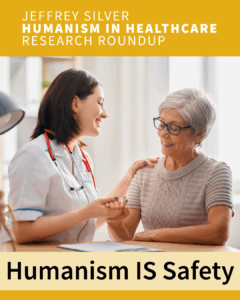 This post is part of our series of Research Roundups — a list of recently published studies on humanism in medicine. If you would like to be notified each time a Research Roundup is published, send an email to bking@gold-foundation.org with the subject line “Subscribe RR”.
This post is part of our series of Research Roundups — a list of recently published studies on humanism in medicine. If you would like to be notified each time a Research Roundup is published, send an email to bking@gold-foundation.org with the subject line “Subscribe RR”.
Publications from Gold Foundation-Affiliated Authors
The essential role of medical ethics education in achieving professionalism: The Romanell Report
Carrese JA, Malek J, Watson K, Lehmann LS, Green MJ, McCullough LB, Geller G, Braddock CH 3rd, Doukas DJ. Acad Med. 2015 Jun;90(6):744-52.
David Doukas is a member of the Foundation’s Medical & Professional Advisory Council
This article presents an analysis of the current state of medical ethics education in the United States, focusing in particular on its essential role in cultivating professionalism among medical learners. Authors offer guidance in several areas: educational goals and objectives, teaching methods, assessment strategies, and other challenges and opportunities (including course structure and faculty development).
“Beginning with the end in mind”: Imagining personal retirement speeches to promote professionalism
Yu E, Wright SM. Acad Med. 2015 Jun;90(6):790-3.
Scott Wright is a Gold Professor
The authors present a technique where interns frame a personal definition of professionalism by composing remarks that might be used to introduce them at their own retirement ceremony following a career in medicine. Investigators coded these students’ speeches and found six recurring themes: aligning behaviors with core values, achieving excellence in medicine, changing the world and giving back, valuing teamwork and relationships, realizing work-life balance, and appreciating a career in medicine.
Transforming educational accountability in medical ethics and humanities education toward professionalism
Doukas DJ, Kirch DG, Brigham TP, Barzansky BM, Wear S, Carrese JA, Fins JJ, Lederer SE. Acad Med. 2015 Jun;90(6):738-43.
David Doukas is a member of the Foundation’s Medical & Professional Advisory Council
In May 2012, an expert panel of nationally known medical educators in ethics, history, literature, and the visual arts met with representatives from the three major medical education and accreditation organizations. This article, based on the views of these representatives and their respondents, offers a future-tense account of how professionalism can be incorporated into medical education.
Other Publications
Effects of electronic health record use on the exam room communication skills of resident physicians: A randomized within-subjects study
Taft T, Lenert L, Sakaguchi F, Stoddard G, Milne C. J Am Med Inform Assoc. 2015 Jan;22(1):192-8.
Researchers performed a within-subjects randomized controlled trial using observed structured clinical examination (OSCE) methods to see how if there was a difference in novice physicians’ communication skills when they were using EHRs vs paper charts. Video recordings of patient interviews were rated using the Four Habits scale. They found that using an EHR on a laptop computer appears to improve the ability of first-year residents to communicate with patients relative to using a paper chart.
How patient-centered do female physicians need to be? Analogue patients’ satisfaction with male and female physicians’ identical behaviors
Hall JA, Roter DL, Blanch-Hartigan D, Mast MS, Pitegoff CA. Health Commun. 2015 Sep;30(9):894-900.
In this experiment, two male and two female actors portrayed physicians speaking to a patient using high or low patient-centered scripts while not varying their nonverbal cues. 192 students assumed the patient role while watching one of the videos and then rated their satisfaction with the physician. Researchers found a pattern consistent with the hypothesis that high verbal patient-centered behavior by female physicians is not recognized as a marker of clinical competence, as it is for male physicians, but is rather seen as expected female behavior.
A schematic representation of the professional identity formation and socialization of medical students and residents: A guide for medical educators
Cruess RL, Cruess SR, Boudreau JD, Snell L, Steinert Y. Acad Med. 2015 Jun;90(6):718-25.
Prolific authors Richard and Sylvia Cruess draw on the identity formation and socialization literature, as well as experience gained in teaching professionalism, to present schematic representations of the process of professional identify formation. These representations aim to guide educators as they aim to explicitly support the ultimate goal of medical education-to ensure that medical students and residents come to “think, act, and feel like a physician.”
The patient-as-partner approach in health care: A conceptual framework for a necessary transition
Karazivan P, Dumez V, Flora L, Pomey MP, Del Grande C, Ghadiri DP, Fernandez N, Jouet E, Las Vergnas O, Lebel P. Acad Med. 2015 Apr;90(4):437-41.
Patients live with their conditions every day and are experts when it comes to their own experiences of illness; this expertise should be welcomed, valued, and fostered by other members of the care team. The author describes the approach of the University of Montreal where patients are not only active members of their own health care team but also are involved in research and health student training.
 This post was written by Brandy King, Head of Information Services at The Arnold P. Gold Foundation Research Institute
This post was written by Brandy King, Head of Information Services at The Arnold P. Gold Foundation Research Institute


